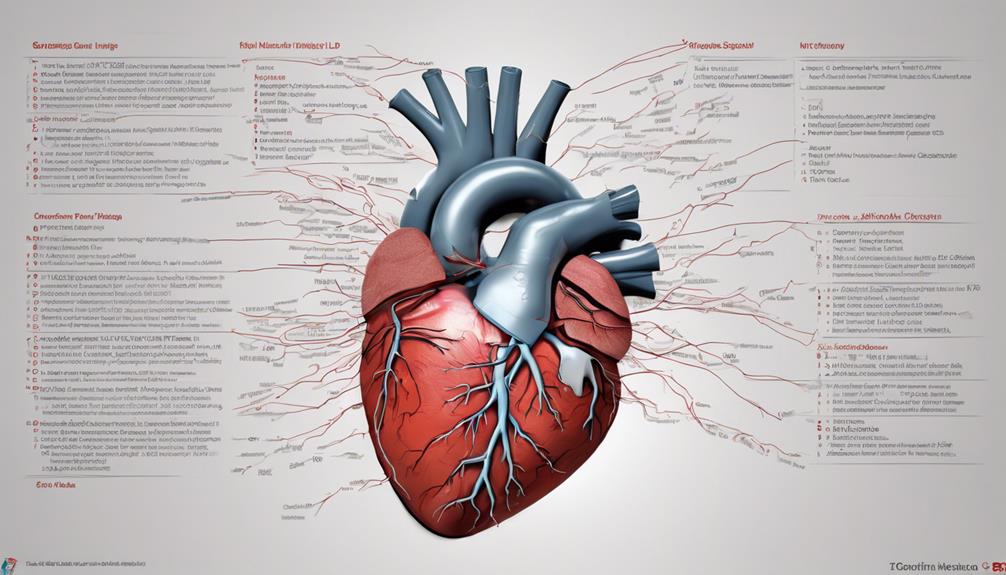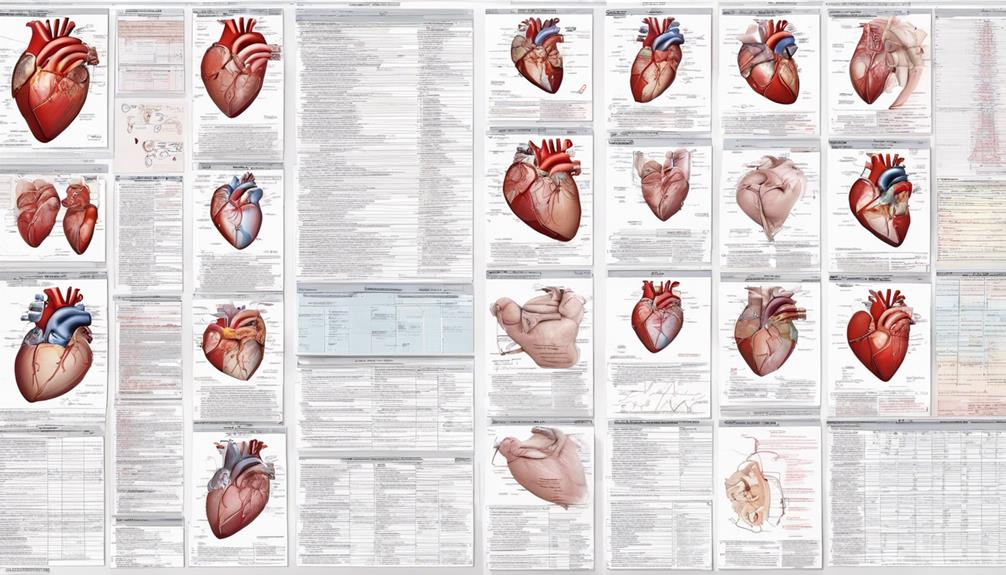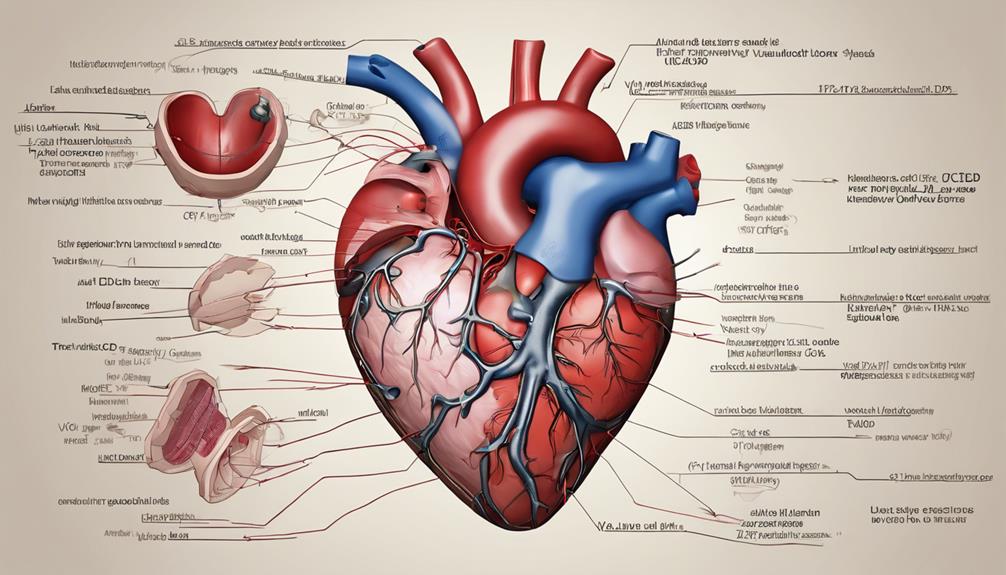We recently discovered an intriguing statistic that highlights the frequency of Ischemic Heart Disease (IHD) in today’s healthcare environment.
With the growing burden of cardiovascular diseases globally, it's essential to understand how the ICD-10 classification system addresses the nuances of IHD. This classification not only provides a structured approach to diagnosing and documenting IHD but also offers insights into the specific codes used for different manifestations of the condition.
As we explore the intricacies of ICD-10 Ischemic Heart Disease, we uncover a wealth of information that can significantly impact patient care and outcomes.
Key Takeaways
- IHD is a significant global health issue.
- Risk factor recognition is crucial.
- Proper ICD-10 coding ensures accuracy.
- Atherosclerosis plays a central role.
Understanding Ischemic Heart Disease
In Ischemic Heart Disease, the coronary arteries experience reduced blood flow, primarily due to atherosclerosis, resulting in various cardiovascular complications. Ischemic heart disease, a leading cause of morbidity and mortality worldwide, poses a significant threat to individuals' health. The condition arises when the heart muscle doesn't receive an adequate supply of oxygen and nutrients due to narrowed or blocked coronary arteries. This insufficiency can lead to angina, myocardial infarction, heart failure, and even sudden cardiac death.
Understanding the pathophysiology of ischemic heart disease is crucial for effective management and prevention strategies. Atherosclerosis, characterized by the buildup of plaque within the arteries, plays a central role in the development of this condition. The progressive narrowing of the coronary arteries restricts blood flow to the heart, impairing its ability to function optimally. Recognizing the risk factors associated with ischemic heart disease, such as hypertension, diabetes, and smoking, is essential for implementing targeted interventions to mitigate these dangers and improve patient outcomes.
Overview of Icd 10 Coding

Understanding the nuances of ICD-10 coding is crucial in accurately categorizing and documenting the various types and stages of ischemic heart diseases for effective diagnosis and billing purposes.
The ICD-10-CM code range I20-I25 plays a vital role in classifying different manifestations of ischemic heart diseases, providing a structured framework for healthcare professionals to identify and record specific conditions.
By adhering to the guidelines set forth in the ICD-10 system, healthcare providers ensure precise documentation, aiding in treatment planning and monitoring patient progress over time.
Proper utilization of ICD-10 coding not only supports accurate diagnosis but also facilitates insurance claims processing, enables robust research initiatives, and allows for comprehensive statistical analysis within the healthcare domain.
Mastery of ICD-10 coding guidelines for ischemic heart diseases is paramount for healthcare facilities seeking appropriate reimbursement and compliance with industry standards, ultimately enhancing the overall quality of care delivery and patient outcomes.
Categories and Subcategories Defined
What distinct classifications and subdivisions characterize the code range I20-I25 in the ICD-10 system for ischemic heart diseases? Within this code range, specific subcategories outline different manifestations of ischemic heart diseases. These subcategories include:
- Angina pectoris (I20)
- Acute myocardial infarction (I21)
- Subsequent myocardial infarction (I22)
- Other forms of chronic ischemic heart disease (I25)
Each subcategory within this range provides detailed criteria for accurate diagnosis and coding, aiding healthcare providers in effectively documenting and billing for services related to these conditions. Proper classification under these subcategories is crucial for planning appropriate treatment strategies and monitoring patients with ischemic heart disease. By utilizing the detailed classifications and subdivisions outlined in the ICD-10 system, healthcare professionals can ensure precise coding, leading to improved patient care and outcomes in the management of ischemic heart diseases.
Diagnosis and Treatment Approaches

Utilizing a comprehensive approach, healthcare providers employ a combination of medical history assessment, physical examinations, electrocardiograms (ECG), and potentially angiography for the definitive evaluation of ischemic heart disease. This systematic process aids in accurately diagnosing the condition and determining the most appropriate treatment plan.
When managing ischemic heart disease, healthcare providers focus on:
- Medical History Assessment: Gathering detailed information about the patient's medical background, risk factors, and symptoms to better understand the underlying causes of ischemic heart disease.
- Physical Examinations: Conducting thorough physical assessments to identify any signs of heart disease, such as abnormal heart sounds or fluid retention, that may indicate ischemic issues.
- Electrocardiograms (ECG): Performing ECG tests to assess the electrical activity of the heart and detect any abnormalities, such as irregular heart rhythms or evidence of prior heart attacks.
These diagnostic tools and approaches play a crucial role in formulating a tailored treatment strategy to effectively manage ischemic heart disease and improve patient outcomes.
Monitoring Patients With Icd 10
Regular monitoring of patients with ICD-10 codes for ischemic heart disease is essential to track disease progression and evaluate the effectiveness of treatments. Monitoring involves various assessments such as regular check-ups, electrocardiograms (ECGs), blood tests, and imaging studies to evaluate cardiac function and detect any complications. This allows healthcare providers to make informed decisions regarding treatment plans, medications, and lifestyle recommendations tailored to the patient's response and overall health status. Evaluating risk factors like blood pressure, cholesterol levels, and blood sugar is also crucial in preventing further cardiovascular complications. Educating patients on self-monitoring techniques, symptom recognition, and adherence to treatment plans is key for long-term management of ischemic heart disease.
| Monitoring Methods | Description |
|---|---|
| Regular Check-ups | Scheduled visits to assess overall health status and disease progression. |
| ECGs, Blood Tests, Imaging Studies | Diagnostic tests to evaluate cardiac function, detect complications, and guide treatment plans. |
Frequently Asked Questions
What Is the ICD 9 Code for Ischemic Heart Disease?
We used to identify ischemic heart disease in the past with the ICD-9 code 414.00, falling under chronic ischemic heart disease. However, since ICD-9 codes are no longer in use, we now rely on the more specific ICD-10 codes.
This transition has provided healthcare providers with a more detailed classification of diseases, allowing for better diagnosis and billing accuracy. The shift from ICD-9 to ICD-10 marked a significant improvement in medical coding practices.
What Is the Ischemic Heart Disease?
When discussing ischemic heart disease, we're referring to a condition where the heart muscle doesn't receive enough blood flow due to atherosclerosis. This can lead to serious issues like angina, heart attacks, and heart failure.
Risk factors include smoking, high blood pressure, and diabetes. Diagnosis is typically made through a combination of medical history, physical exams, ECG, and angiography to accurately assess the condition.
What Is the ICD-10 Code for I25 13?
We've got the answer you need!
The ICD-10 code for I25.13 is specific to atherosclerotic heart disease of the native coronary artery with unstable angina pectoris. It falls under the I25 category in the ICD-10-CM coding system, essential for accurate medical billing and patient tracking.
This code highlights atherosclerosis in the coronary artery leading to unstable angina, aiding healthcare providers in documenting and managing cases effectively.
What Is the ICD-10 Code for I25 29?
The ICD-10 code for I25.29 is crucial for identifying and managing specific chronic ischemic heart disease conditions. It aids in accurate documentation, billing, and tracking of patients for effective treatment.
Healthcare providers rely on this code for coding and reporting, ensuring precise identification of the ischemic heart disease type. Proper utilization of I25.29 allows for tailored care plans and monitoring of patients with various manifestations and severity levels.
Conclusion
In conclusion, the ICD-10 coding system for ischemic heart disease provides a comprehensive framework for accurate diagnosis and treatment.
One interesting statistic to note is that IHD accounts for approximately 1 in 7 deaths in the United States, highlighting the significant impact of this condition on public health.
It's crucial for healthcare professionals to stay updated on the latest coding guidelines to effectively monitor and manage patients with ICD-10 diagnoses.









